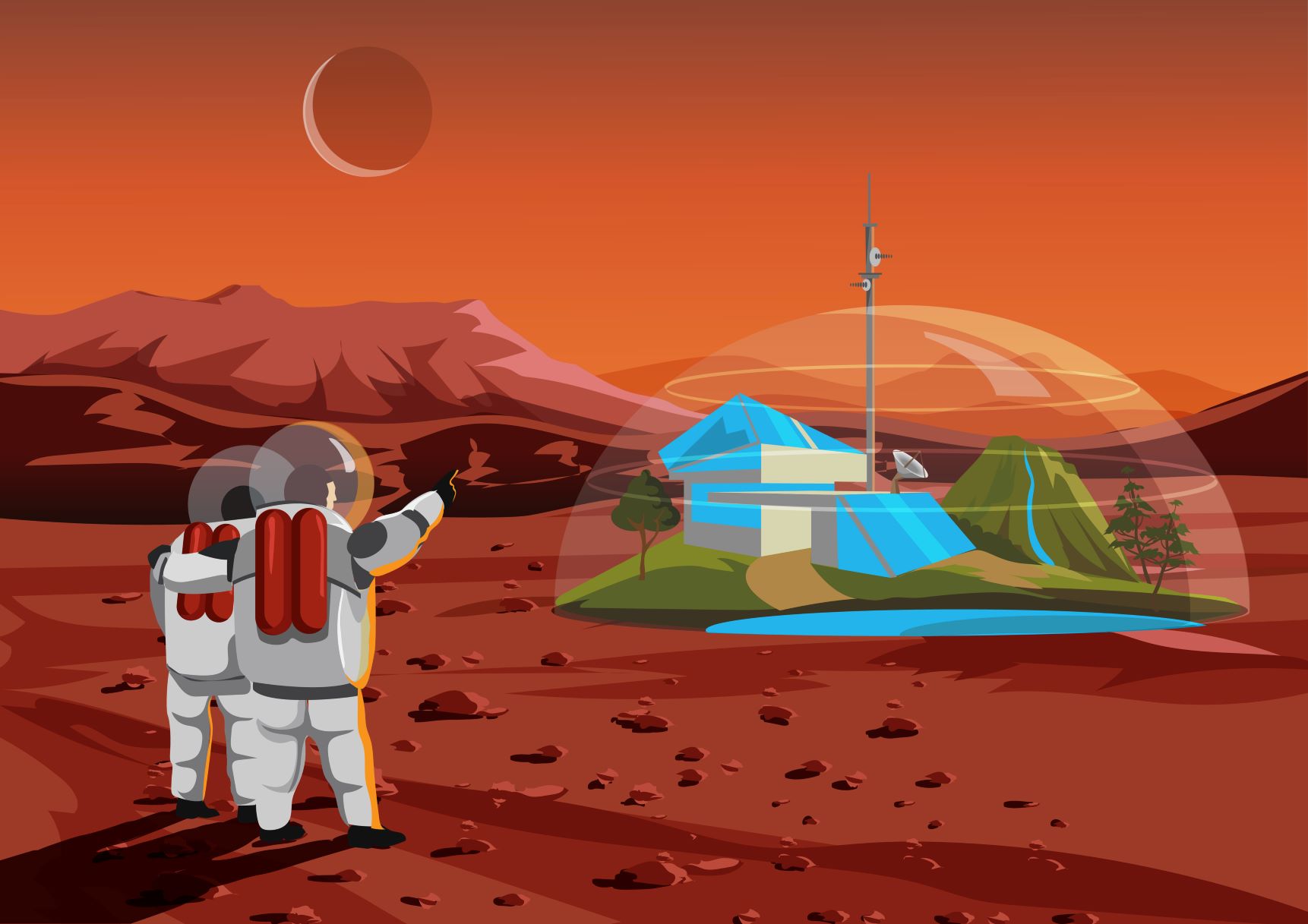
From Mars Rovers to the Webb telescope, exciting space discoveries are happening in our time! And now, with the Artemis I mission, we will begin to explore space deeper than ever before. As the NASA Artemis I mission paves the way for exploration of Mars, the question remains, can we live on Mars?
Have you ever thought “Why can’t we live on Mars”? The answer seems to be “it’s possible”. Many scientists consider Mars and Earth twins because of the similarities between the planets. But they aren’t entirely alike.
Also, you may think of “What challenges might humans face to live on Mars?”.Some challenges would need to be overcome before humans could start calling Mars home. We need to consider many things – the differences between Earth and Mars, how long a day on Mars, what are our basic survival needs, and more.
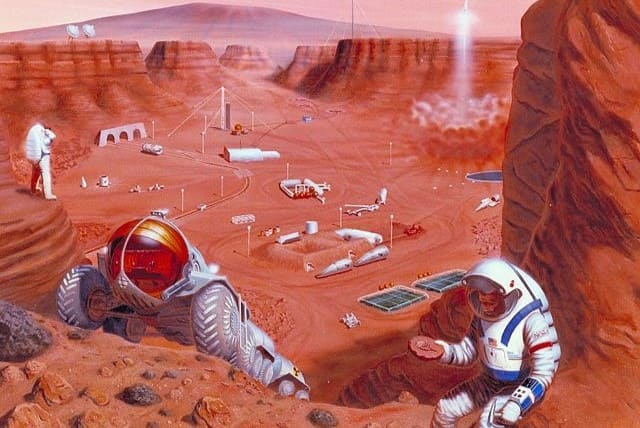
NASA, Public domain, via Wikimedia Commons
Differences Between Earth and Mars
There are some similarities between Earth and Mars, such as the fact that they both rotate around the sun and have a similar axis tilt. However, there are important differences between the two planets, such as:
Atmosphere
The Earth’s atmosphere is composed of nitrogen and oxygen. Mars, on the other hand, is carbon-dioxide based.
Ice caps
While both planets have ice caps, the ice contains different elements. On Earth, ice contains just water. On Mars, ice is a mixture of water and carbon dioxide.
Surface
Mars’ surface is rock and dust, while Earth’s surface is 70 percent water.
Orbits
Two satellites orbit Mars, namely, Phobos and Deimos. The moon is the only satellite to orbit the Earth.
Temperature
Some climates on Earth experience extreme temperature shifts between seasons. However, that does not compare to what humans would encounter on Mars.
According to the National Weather Service, the average temperature on Mars is -81 degrees Fahrenheit. It can get to -220 degrees in winter, while in summer, it can be a pleasant +70.
Length of time
The time it takes Mars to orbit the sun is longer than it is for Earth. However, a day on Mars is about the same amount of time as it is on Earth. This is a huge bonus in scientists’ minds. How long is a Mars day? Read on to find out more.
Students interested in finding out more about the Red Planet and the challenges of living on Mars can join Engineering For Kids®’ Mission to Mars program. In this program, we embark on an exciting exploration of Mars in conjunction with STEM concepts.
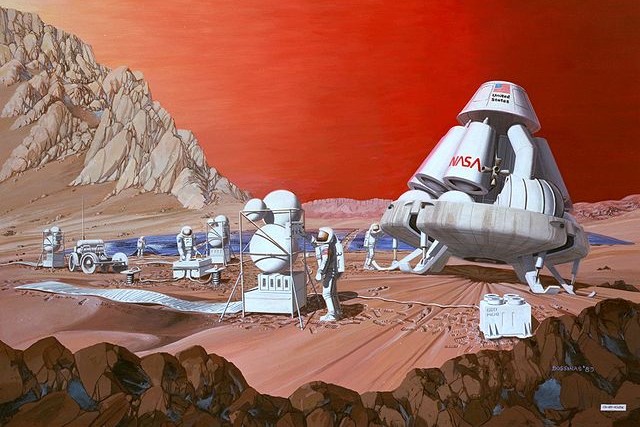
NASA Ames Research Center, Public domain, via Wikimedia Commons
Challenges of Living on Mars
There are four primary necessities for human survival. These are water, shelter, food, and oxygen. And these are all issues that we must address as we ponder – can people live on Mars?
Water on Mars
Scientists have found water on Mars, but not in the same form it’s found on Earth. There is some water on the surface and below, but because of the extreme cold on Mars, it is all ice. And not the ice as we experience on Earth. On Earth, ice is just water, but on Mars, with high levels of CO2, ice contains water ice mixed with CO2 ice.
There is also water inside of rocks, but the lack of surface water would be a challenge for humans wanting to settle on Mars. Scientists continue to learn more about Mars, which will help them find out where we can obtain water from.
Shelter on Mars
Building places to live on Mars poses a challenge. Transporting construction materials to Mars could end up being way too expensive. So, scientists propose the possibility of using materials from Mars to construct homes.
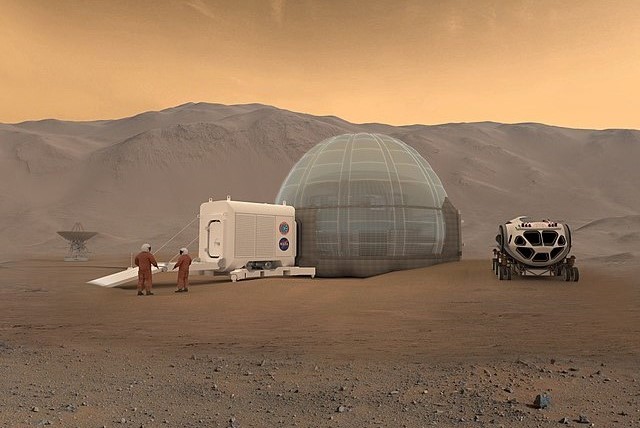
NASA/Clouds AO/SEArch, Public domain, via Wikimedia Commons
Homes on Mars would need to withstand radiation levels, temperature fluctuations, lack of oxygen, and other conditions on Mars. And new environments call for alternative structures. A few possibilities are that humans could live in ice igloos or below the ground surface. Also, many designers have created above-the-surface habitats that fit the necessary specifications.
Food on Mars
Growing food on Mars won’t look like the farms that we have on Earth. Instead, crops would need to be grown without soil, such as tank farming or aquaculture. This is where the food would be planted in nutrient-rich water and fed with artificial lights.
Some scientists have discussed creating a more suitable atmosphere for growing food on Mars. That would involve adding some greenhouse gases into the Martian atmosphere to make it thicker. However, due to the enormity of that project, it’s more realistic to think that humans living on Mars would rely on aquaculture.
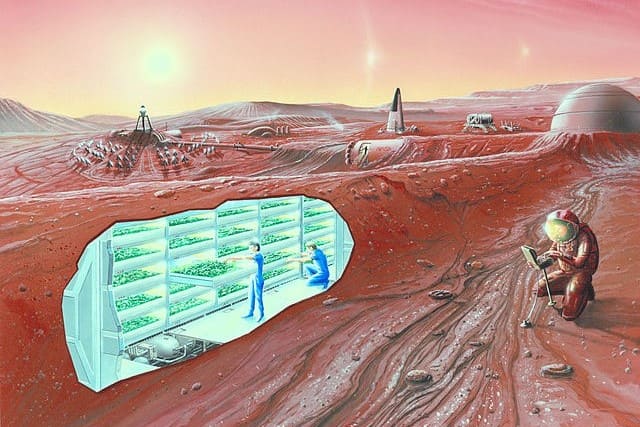
NASA Ames Research Center, Public domain, via Wikimedia Commons
Air on Mars
Humans need oxygen to survive. And the Earth provides plenty in our atmosphere. So, one of the biggest challenges of putting people on the planet is the shortage of oxygen. The air on Mars is thinner than that on Earth.
On Earth, 21 percent of the air is oxygen, which is what makes it the ideal place for human life. But on Mars, oxygen makes up 0.13 percent of the air. The majority is carbon dioxide, which is harmful to humans.
NASA has been experimenting with MOXIE, an instrument that would convert CO2 to oxygen on Mars.
So far, this instrument on the Mars Perseverance rover has managed to successfully create oxygen from CO2. This leads the way for bigger experiments and possibilities for air on Mars.
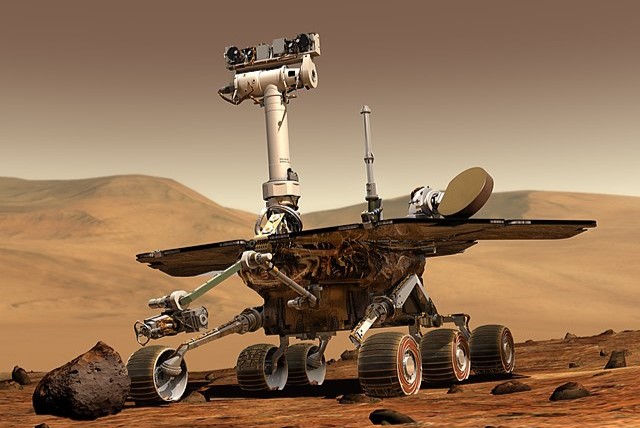
NASA Ames Research Center, Public domain, via Wikimedia Commons
Other Challenges of Living on Mars
Aside from the necessities to sustain life, there are other challenges that people would face if they were to live on Mars. For example, the temperature gets very, very cold at night, below -100 degrees Fahrenheit.
Mars also has dust storms, high levels of radiation, and less gravity than Earth. So, before we can start to call the Red Planet home, we’ll need to solve these problems.
How E4K is Helping Solve the Challenges of Living on Mars
our programs allow them to explore their imaginations.
Find the Engineering For Kids® locations closest to you! Help your child delve into a meaningful STEM education experience.




